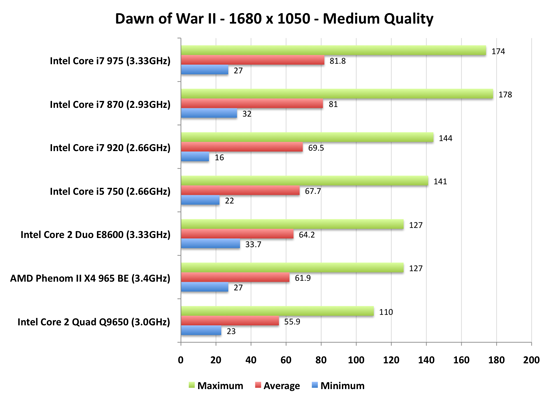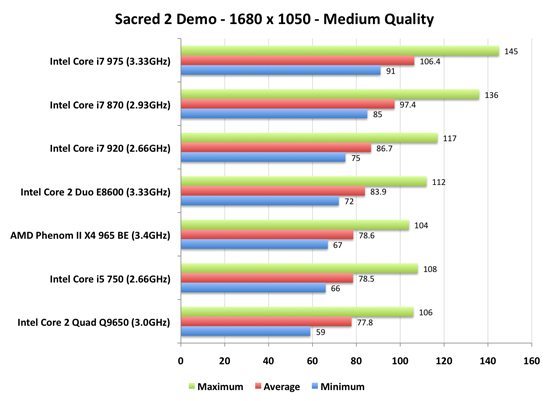Intel's Core i7 870 & i5 750, Lynnfield: Harder, Better, Faster Stronger
by Anand Lal Shimpi on September 8, 2009 12:00 AM EST- Posted in
- CPUs
The Best Gaming CPU?
When I first previewed Lynnfield I theorized that its aggressive turbo modes would make it the best gaming CPU on the market. Most games these days use between two and four threads, not enough for Hyper Threading to be truly beneficial. As a result, Nehalem never really did all that well in games. It was generally faster than the competition, but not much and not on a performance-per-dollar basis.
I ran a few new game tests under Windows 7 to accompany our usual game benchmarks. The competitors here are limited to Lynnfield (of course), Bloomfield, Penryn and AMD's Phenom II.

Dawn of War II doesn't actually shatter any expectations. While turbo clearly benefits Lynnfield, it isn't enough to dethrone Bloomfield. The Core i7 920 is marginally faster than the new i5 750. Here's where things get interesting though: look at minimum frame rates. In both Lynnfield platforms, the minimum frame rates are higher than the competing Bloomfield system. That appears to be Lynnfield's aggressive turbo modes at work. While they're not constantly pushing Lynnfield to a higher clock speed, they do apparently help out when it matters the most.
The other thing to notice is the lowest Lynnfield is a faster gaming CPU than Intel's fastest dual-core: the E8600.

Sacred 2 is an example of performance standings in a more normal manner. Lynnfield can't seem to outperform Bloomfield, and the Core i5 750 actually falls slightly behind AMD's Phenom II X4 965 BE.

With World of Warcraft we're back to turbo mode having a very positive impact. The Core i7 870 is nearly as fast as the i7 975, while the i5 750 is a bit slower than the i7 920. Both are faster than the Phenom II X4 965 BE, which is in turn faster than the Q9650.
These three benchmarks seem to outline the three most realistic options for Lynnfield's gaming performance. In situations where its turbo modes can work, Lynnfield can be equal to if not faster than Bloomfield. In those situations where it doesn't kick in, Lynnfield is at least competitive with Phenom II and Bloomfield. In all situations the old Core 2 Quad Q9650 is at the bottom of the charts.
I'll throw in one more option just to complicate things. Have a look at this:

Not exactly the norm, but here we have the Phenom II X4 965 BE faster than everything - including the Core i7 975. Unfortunately there's no one benchmark that will sum up how these things perform, but overall it looks like Lynnfield is going to be one capable gaming CPU.










343 Comments
View All Comments
jnr0077 - Thursday, July 26, 2012 - link
well i have the better model i5 750 1156 socket gaming score is 5.9 on basic 500 gb hd 7200 with a ssd it hit 7.9 on a gigabyte GA-P55A-UD6 12gb ram. as for the pricecost was cheep intel (R)quad core (TM) i5 750 @2.66 GHz 2.67GHz cost around £100 mobo cost me £100 i though it is a very cheep upgrade considering price i wood like to here what score any Pehnom II X4 965 hit
Milleman - Sunday, September 13, 2009 - link
The article itself is good. But Why on earth compare a standard clocked CPU (AMD) against overclocked ones (Intel). Makes no objective sense att all. I's like having a car test between a standard car and a tuned racecar. Of course the racecar will win in performance. The overclock results shouldn't be there at all. Maybe as a remark that tell what will happen if one would like to overclock. Looks rather unfair and biased.So... why??
Nich0 - Sunday, September 13, 2009 - link
All I saw in this article is comparison of CPUs in their stock configuration. What's wrong with that?Bozo Galora - Friday, September 11, 2009 - link
I must say this was a very good logical coherent review with just about all the info one would requireGood job - I had no intention of getting one of these, but now I may change my mind
IntelUser2000 - Thursday, September 10, 2009 - link
http://www.intel.com/support/processors/sb/CS-0299...">http://www.intel.com/support/processors/sb/CS-0299...According to Intel...
Core i7 870:
5/4/2/2
Core i7 860:
5/4/1/1/
Core i5 750:
4/4/1/1
So the i7 870 has higher Turbo mode for 3 and 4 cores than 860 does.
Nich0 - Friday, September 11, 2009 - link
Yeah and that means that the OC numbers for the 750 with Turbo don't make sense. For example 4160 / 160 = 26 which would be a Turbo of 6 BCLK.Same thing for the 860 OC 3C/4C Turbo number.
Am I missing something?
IntelUser2000 - Friday, September 11, 2009 - link
Its likely Anand has ES versions or such which allows multiplier adjustments. But at stock, the linked speeds are the Turbo Boost grades.Nich0 - Friday, September 11, 2009 - link
Yeah obviously I am not disputing the stock OC with Turbo enabled (that sounds weird: stock OC?), ie 160*20= 3200, but just what it means in terms of Turbo: it 'should' read 3.36 for 3/4C and 3.84 for 1/2C if the 1/1/4/4 Turbo spec is correct.rdkone - Thursday, September 10, 2009 - link
I don't like the fact that the BCLK directly and synchronously communicates with PCIe buss, thus affecting the videocard negatively (among other PCIe cards)... This is like overclocking years ago whereas the PCI bus would be affected in the same way and causing headaches... This is a major issue I feel for those wanting to push a fairly big overclock on these CPU's... Intel screwed the pooch for us overclockers I feel... Just more justification to limp along with my core 2 quad at 4.1Ghz rock solid... Like others have said, is funny how the articles don't show older CPU overclocks against all this new garb... In the past they used to... But that hurts sales : )SnowleopardPC - Thursday, September 10, 2009 - link
Ok, so what type of boost do I get over a Q6600 with 8gb of ram and windows 7 64?Is it worth upgrading or waiting for that 6 core 32nm to come out next year?
To upgrade to any of these I will need to replace a motherboard and ram with the processor.